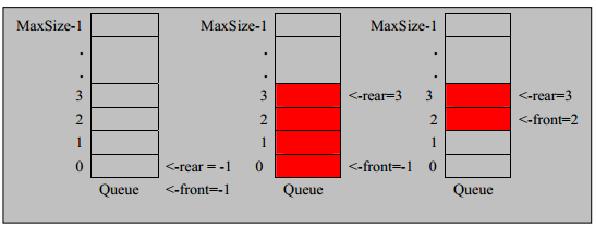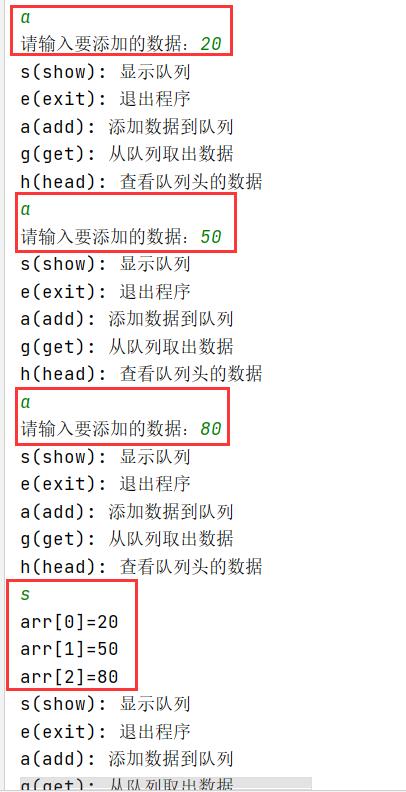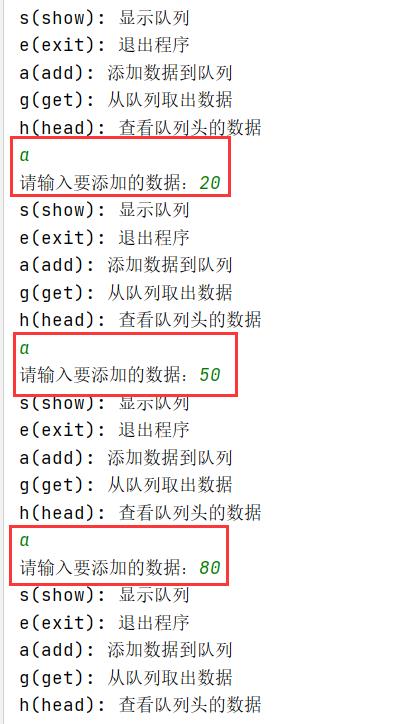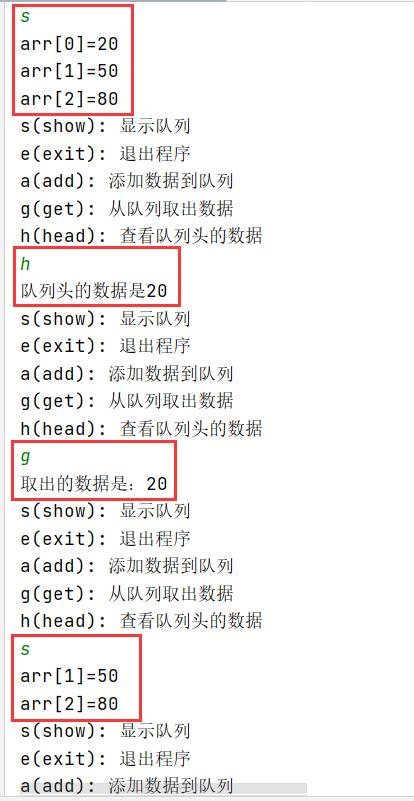Java数据结构与算法——队列
Posted 张起灵-小哥
tags:
篇首语:本文由小常识网(cha138.com)小编为大家整理,主要介绍了Java数据结构与算法——队列相关的知识,希望对你有一定的参考价值。
1.简介
队列是一个有序列表,可以用数组或是链表来实现。遵循先入先出的原则。即:先存入队列的数据,要先取出。后存入的要后取出。
队列本身是有序列表,若使用数组的结构来存储队列的数据,则队列数组的声明如下图, 其中 maxSize 是该队列的最大容量。
因为队列的输出、输入是分别从前后端来处理,因此需要两个变量 front及 rear分别记录队列前后端的下标,front 会随着数据输出而改变,而 rear则是随着数据输入而改变,如图所示:

2.数组模拟普通队列
当我们将数据存入队列时称为”addQueue”,addQueue 的处理需要有两个步骤:思路分析
将尾指针往后移:rear+1 , 当front == rear 【空】
若尾指针 rear 小于队列的最大下标 maxSize-1,则将数据存入 rear所指的数组元素中,否则无法存入数据。 rear == maxSize - 1[队列满]
package com.szh.queue;
import java.util.Scanner;
/**
*
*/
class ArrayQueue
private Integer maxSize; //队列的最大容量
private Integer front; //队列头
private Integer rear; //队列尾
private Integer[] arr; //数组模拟队列
public ArrayQueue(Integer maxSize)
this.maxSize = maxSize;
arr = new Integer[this.maxSize]; //创建队列
this.front = -1; //指向队列头的前一个位置
this.rear = -1; //指向队列尾的当前位置
//判断队列是否已满
public boolean isFull()
return rear == maxSize - 1;
//判断队列是否为空
public boolean isEmpty()
return rear == front;
//向队列中添加数据
public void addQueue(int n)
if (isFull())
System.out.println("队列已满,无法继续添加数据。");
return;
arr[++rear] = n;
//从队列中取出数据
public int getQueue()
if (isEmpty())
throw new RuntimeException("队列已空,无法继续取出数据。");
return arr[++front];
//显示队列中所有的数据
public void showQueue()
if (isEmpty())
System.out.println("队列空的,没有数据....");
return;
for (int i = 0; i < arr.length; i++)
System.out.printf("arr[%d]=%d\\n", i, arr[i]);
//显示队列的头数据
public int headQueue()
if (isEmpty())
throw new RuntimeException("队列空的,没有数据....");
return arr[front + 1];
public class ArrayQueueDemo
public static void main(String[] args)
//创建一个队列
ArrayQueue arrayQueue = new ArrayQueue(3);
Scanner input = new Scanner(System.in);
char key = ' ';
boolean loop = true;
//菜单循环
while (loop)
System.out.println("s(show): 显示队列");
System.out.println("e(exit): 退出程序");
System.out.println("a(add): 添加数据到队列");
System.out.println("g(get): 从队列取出数据");
System.out.println("h(head): 查看队列头的数据");
key = input.next().charAt(0); //从控制台接收一个字符
switch (key)
case 's':
arrayQueue.showQueue();
break;
case 'a':
System.out.print("请输入要添加的数据:");
int value = input.nextInt();
arrayQueue.addQueue(value);
break;
case 'g':
int res = arrayQueue.getQueue();
System.out.println("取出的数据是:" + res);
break;
case 'h':
int ans = arrayQueue.headQueue();
System.out.printf("队列头的数据是%d\\n", ans);
break;
case 'e':
input.close();
loop = false;
break;
default:
break;
System.out.println("程序退出....");

3.数组模拟环形队列
对前面的数组模拟队列的优化,充分利用数组. 因此将数组看做是一个环形的。(通过取模的方 式来实现即可)
分析说明:尾索引的下一个为头索引时表示队列满,即将队 列容量空出一个作为约定,这个在做判断队列满的 时候需要注意 (rear + 1) % maxSize == front 满]
rear == front [空]
package com.szh.queue;
import java.util.Scanner;
/**
*
*/
class CircleArrayQueue
private int maxSize; // 表示数组的最大容量
//front 变量的含义做一个调整: front 就指向队列的第一个元素, 也就是说 arr[front] 就是队列的第一个元素
//front 的初始值 = 0
private int front;
//rear 变量的含义做一个调整:rear 指向队列的最后一个元素的后一个位置. 因为希望空出一个空间做为约定.
//rear 的初始值 = 0
private int rear; // 队列尾
private int[] arr; // 该数据用于存放数据, 模拟队列
public CircleArrayQueue(int maxSize)
this.maxSize = maxSize;
arr = new int[maxSize];
this.front = 0;
this.rear = 0;
//判断队列是否已满
public boolean isFull()
return (rear + 1) % maxSize == front;
//判断队列是否为空
public boolean isEmpty()
return rear == front;
//向队列中添加数据
public void addQueue(int n)
if (isFull())
System.out.println("队列已满,无法继续添加数据。");
return;
//直接将数据加入
arr[rear] = n;
//将 rear 后移, 这里必须考虑取模
rear = (rear + 1) % maxSize;
//从队列中取出数据
public int getQueue()
if (isEmpty())
throw new RuntimeException("队列已空,无法继续取出数据。");
//这里需要分析出 front 是指向队列的第一个元素
//先把 front 对应的值保留到一个临时变量
int res = arr[front];
//将 front 后移, 考虑取模
front = (front + 1) % maxSize;
//将临时保存的变量返回
return res;
//显示队列中所有的数据
public void showQueue()
if (isEmpty())
System.out.println("队列空的,没有数据....");
return;
int num = size();
for (int i = front; i < front + num; i++)
System.out.printf("arr[%d]=%d\\n", i % maxSize, arr[i % maxSize]);
//显示队列的头数据
public int headQueue()
if (isEmpty())
throw new RuntimeException("队列空的,没有数据....");
return arr[front];
// 求出当前队列有效数据的个数
public int size()
return (rear + maxSize - front) % maxSize;
public class CircleArrayQueueDemo
public static void main(String[] args)
//创建一个队列, 说明设置4, 其队列的有效数据最大是3
CircleArrayQueue arrayQueue = new CircleArrayQueue(4);
Scanner input = new Scanner(System.in);
char key = ' ';
boolean loop = true;
//菜单循环
while (loop)
System.out.println("s(show): 显示队列");
System.out.println("e(exit): 退出程序");
System.out.println("a(add): 添加数据到队列");
System.out.println("g(get): 从队列取出数据");
System.out.println("h(head): 查看队列头的数据");
key = input.next().charAt(0); //从控制台接收一个字符
switch (key)
case 's':
arrayQueue.showQueue();
break;
case 'a':
System.out.print("请输入要添加的数据:");
int value = input.nextInt();
arrayQueue.addQueue(value);
break;
case 'g':
int res = arrayQueue.getQueue();
System.out.println("取出的数据是:" + res);
break;
case 'h':
int ans = arrayQueue.headQueue();
System.out.printf("队列头的数据是%d\\n", ans);
break;
case 'e':
input.close();
loop = false;
break;
default:
break;
System.out.println("程序退出....");


以上是关于Java数据结构与算法——队列的主要内容,如果未能解决你的问题,请参考以下文章